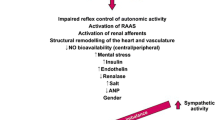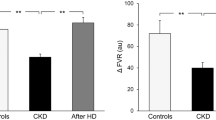Abstract
Abundant evidence shows that chronic kidney disease (CKD) is a disease state characterized by increased sympathetic activation. Kidney injury (ischemia) plays a central role in this pathogenesis. Sympathetic excitation is associated with an increased risk of cardiovascular morbidity and mortality. Several pharmacologic strategies are developed to decrease sympathetic activity. However, these medications have limitations. Percutaneous catheter-based renal denervation has the potential to become a new treatment option for CKD. This current report focuses on the effects of sympathetic hyperactivity in CKD, and gives an overview in experimental as well as clinical evidence for a central role of the kidneys in the pathophysiology of sympathetic hyperactivity. Moreover, the effect of pharmacologic treatment and the potential beneficial effect of renal denervation will be discussed.

Similar content being viewed by others
References
Papers of particular interest, published recently, have been highlighted as: • Of importance
Matsushita K, van der Velde M, Astor BC, et al. Association of estimated glomerular filtration rate and albuminuria with all-cause and cardiovascular mortality in general population cohorts: a collaborative meta-analysis. Lancet. 2010;375:2073–81.
Go AS, Chertow GM, Fan D, et al. Chronic kidney disease and the risks of death, cardiovascular events, and hospitalization. N Engl J Med. 2004;351:1296–305.
Mahmoodi BK, Matsushita K, Woodward M, et al. Associations of kidney disease measures with mortality and end-stage renal disease in individuals with and without hypertension: a meta-analysis. Lancet. 2012;380:1649–61.
Zoccali C, Mallamaci F, Parlongo S, et al. Plasma norepinephrine predicts survival and incident cardiovascular events in patients with end-stage renal disease. Circulation. 2002;105:1354–9.
Penne EL, Neumann J, Klein IH, et al. Sympathetic hyperactivity and clinical outcome in chronic kidney disease patients during standard treatment. J Nephrol. 2009;22:208–15.
Esler M, Jennings G, Lambert G, et al. Overflow of catecholamine neurotransmitters to the circulation: source, fate, and functions. Physiol Rev. 1990;70:963–85.
Malpas SC. Sympathetic nervous system overactivity and its role in the development of cardiovascular disease. Physiol Rev. 2010;90:513–57.
Fagius J, Wallin BG. Long-term variability and reproducibility of resting human muscle nerve sympathetic activity at rest, as reassessed after a decade. Clin Auton Res. 1993;3:201–5.
Siddiqi L, Prakken NH, Velthuis BK, et al. Sympathetic activity in chronic kidney disease patients is related to left ventricular mass despite antihypertensive treatment. Nephrol Dial Transplant. 2010;25:3272–7.
Siddiqi L, Oey PL, Blankestijn PJ. Aliskiren reduces sympathetic nerve activity and blood pressure in chronic kidney disease patients. Nephrol Dial Transplant 2011;11:2176–80.
Ligtenberg G, Blankestijn PJ, Oey PL, et al. Reduction of sympathetic hyperactivity by enalapril in patients with chronic renal failure. N Engl J Med. 1999;340:1321–8.
Klein IHHT, Ligtenberg G, Oey PL, et al. Sympathetic activity is increased in polycystic kidney disaese and is associated with hypertension. J Am Soc Nephrol. 2001;12:2427–33.
Klein IH, Ligtenberg G, Oey PL, et al. Enalapril and losartan reduce sympathetic hyperactivity in patients with chronic renal failure. J Am Soc Nephrol. 2003;14:425–30.
Neumann J, Ligtenberg G, Oey L, et al. Moxonidine normalizes sympathetic hyperactivity in patients with eprosartan-treated chronic renal failure. J Am Soc Nephrol. 2004;15:2902–7.
Wallin BG, Esler M, Dorward P, et al. Simultaneous measurements of cardiac noradrenaline spillover and sympathetic outflow to skeletal muscle in humans. J Physiol. 1992;453:45–58.
Wallin BG, Thompson JM, Jennings GL, Esler MD. Renal noradrenaline spillover correlates with muscle sympathetic activity in humans. J Physiol. 1996;491(Pt 3):881–7.
Reid IA. Interactions between ANG II, sympathetic nervous system, and baroreceptor reflexes in regulation of blood pressure. Am J Physiol. 1992;262:E763–78.
Ye S, Gamburd M, Mozayeni P, et al. A limited renal injury may cause a permanent form of neurogenic hypertension. Am J Hypertens. 1998;11:723–8.
Campese VM, Kogosov E. Renal afferent denervation prevents hypertension in rats with chronic renal failure. Hypertension. 1995;25:878–82.
Campese VM, Kogosov E, Koss M. Renal afferent denervation prevents the progression of renal disease in the renal ablation model of chronic renal failure in the rat. Am J Kidney Dis. 1995;26:861–5.
Bigazzi R, Kogosov E, Campese VM. Altered norepinephrine turnover in the brain of rats with chronic renal failure. J Am Soc Nephrol. 1994;4:1901–7.
Katholi RE, Whitlow PL, Hageman GR, Woods WT. Intrarenal adenosine produces hypertension by activating the sympathetic nervous system via the renal nerves in the dog. J Hypertens. 1984;2:349–59.
Koomans HA, Blankestijn PJ, Joles JA. Sympathetic hyperactivity in chronic renal failure: a wake-up call. J Am Soc Nephrol. 2004;15:524–37.
Converse Jr RL, Jacobsen TN, Toto RD, et al. Sympathetic overactivity in patients with chronic renal failure. N Engl J Med. 1992;327:1912–8.
Hausberg M, Kosch M, Harmelink P, et al. Sympathetic nerve activity in end-stage renal disease. Circulation. 2002;106:1974–9.
Klein IH, Ligtenberg G, Neumann J, et al. Sympathetic nerve activity is inappropriately increased in chronic renal disease. J Am Soc Nephrol. 2003;14:3239–44.
Grassi G, Quarti-Trevano F, Seravalle G, et al. Early sympathetic activation in the initial clinical stages of chronic renal failure. Hypertension. 2011;57:846–51.
Grassi G, Cattaneo BM, Seravalle G, et al. Baroreflex control of sympathetic nerve activity in essential and secondary hypertension. Hypertension. 1998;31:68–72.
Gabow PA, Chapman AB, Johnson AM, et al. Renal structure and hypertension in autosomal dominant polycystic kidney disease. Kidney Int. 1990;38:1177–80.
Miyajima E, Yamada Y, Yoshida Y, et al. Muscle sympathetic nerve activity in renovascular hypertension and primary aldosteronism. Hypertension. 1991;17:1057–62.
Amann K, Rump LC, Simonaviciene A, et al. Effects of low dose sympathetic inhibition on glomerulosclerosis and albuminuria in subtotally nephrectomized rats. J Am Soc Nephrol. 2000;11:1469–78.
Veelken R, Vogel EM, Hilgers K, et al. Autonomic renal denervation ameliorates experimental glomerulonephritis. J Am Soc Nephrol. 2008;19:1371–8.
Takamitsu Y, Nakanishi T, Nishihara F, et al. A nitric oxide-generating beta-blocking agent prevents renal injury in the rat remnant kidney model. Comparative study of two beta-blocking drugs, nipradilol and propranolol. Nephron Physiol. 2003;93:42–50.
Brooks DP, Short BG, Cyronak MJ, et al. Comparison between carvedilol and captopril in rats with partial ablation-induced chronic renal failure. Br J Pharmacol. 1993;109:581–6.
Nagasu H, Satoh M, Kuwabara A, et al. Renal denervation reduces glomerular injury by suppressing NAD(P)H oxidase activity in Dahl salt-sensitive rats. Nephrol Dial Transplant. 2010;25:2889–98.
Modlinger PS, Wilcox CS, Aslam S. Nitric oxide, oxidative stress, and progression of chronic renal failure. Semin Nephrol. 2004;24:354–65.
Vonend O, Marsalek P, Russ H, et al. Moxonidine treatment of hypertensive patients with advanced renal failure. J Hypertens. 2003;21:1709–17.
Wallin BG, Sundlof G, Stromgren E, Aberg H. Sympathetic outflow to muscles during treatment of hypertension with metoprolol. Hypertension. 1984;6:557–62.
Burns J, Mary DA, Mackintosh AF, et al. Arterial pressure lowering effect of chronic atenolol therapy in hypertension and vasoconstrictor sympathetic drive. Hypertension. 2004;44:454–8.
Bakris GL, Hart P, Ritz E. Beta blockers in the management of chronic kidney disease. Kidney Int. 2006;70:1905–13.
Grassi G, Seravalle G, Turri C, et al. Short-versus long-term effects of different dihydropyridines on sympathetic and baroreflex function in hypertension. Hypertension. 2003;41:558–62.
Siddiqi L, Joles JA, Oey PL, Blankestijn PJ. Atorvastatin reduces sympathetic activity in patients with chronic kidney disease. J Hypertens. 2011;29:2176–80.
Menon DV, Arbique D, Wang Z, et al. Differential effects of chlorthalidone versus spironolactone on muscle sympathetic nerve activity in hypertensive patients. J Clin Endocrinol Metab. 2009;94:1361–6.
Raheja P, Price A, Wang Z, et al. Spironolactone prevents chlorthalidone-induced sympathetic activation and insulin resistance in hypertensive patients. Hypertension. 2012;60:319–25.
Peet MM. Hypertension and its surgical treatment by bilateral supradiaphragmatic splanchnicectomy. Am J Surg. 1948;75:48–68.
Krum H, Schlaich M, Whitbourn R, et al. Catheter-based renal sympathetic denervation for resistant hypertension: a multicentre safety and proof-of-principle cohort study. Lancet. 2009;373:1275–81.
• Esler MD, Krum H, Sobotka PA, et al. Renal sympathetic denervation in patients with treatment-resistant hypertension (The Symplicity HTN-2 Trial): a randomised controlled trial. Lancet. 2010;376:1903–9. The first randomized controlled trial investigating safety and efficacy of renal denervation as treatment of resistant hypertension.
Symplicity HTN-1 Investigators. Catheter-based renal sympathetic denervation for resistant hypertension: durability of blood pressure reduction out to 24 months. Hypertension. 2011;57:911–7.
• Schlaich MP, Sobotka PA, Krum H, et al. Renal sympathetic-nerve ablation for uncontrolled hypertension. N Engl J Med. 2009;361:932–4. The first report investigating the effect of renal denervation on MSNA.
• Brinkmann J, Heusser K, Schmidt BM et al. Catheter-based renal nerve ablation and centrally generated sympathetic activity in difficult-to-control hypertensive patients: prospective case series. Hypertension 2012;11:1485–90. One of the first reports investigating the effect of renal denervation on MSNA.
• Hering D, Lambert EA, Marusic P et al. Substantial reduction in single sympathetic nerve firing after renal denervation in patients with resistant hypertension. Hypertension 2012;2:457–64. One of the first reports investigating the effect of renal denervation on MSNA.
Vink EE, Blankestijn PJ. Catheter-based renal nerve ablation and centrally generated sympathetic activity in difficult-to-control hypertensive patients. Hypertension 2012;61:e8.
• Brandt MC, Mahfoud F, Reda S, et al. Renal sympathetic denervation reduces left ventricular hypertrophy and improves cardiac function in patients with resistant hypertension. J Am Coll Cardiol. 2012;59:901–9. The first randomized controlled trial investigating the effect of renal denervation on left ventricular hypertrophy in patients with hypertension.
Mahfoud F, Schlaich M, Kindermann I, et al. Effect of renal sympathetic denervation on glucose metabolism in patients with resistant hypertension: a pilot study. Circulation. 2011;123:1940–6.
• Hering D, Mahfoud F, Walton AS et al. Renal denervation in moderate to severe CKD. J Am Soc Nephrol 2012. The first pilot study investigating safety and efficacy of renal denervation in CKD.
Di Danielle DN, De FM, Violo L, et al. Renal sympathetic nerve ablation for the treatment of difficult-to-control or refractory hypertension in a haemodialysis patient. Nephrol Dial Transplant. 2012;27:1689–90.
Ott C, Schmid A, Ditting T, et al. Renal denervation in a hypertensive patient with end-stage renal disease and small arteries: a direction for future research. J Clin Hypertens. 2012;14:799–801.
Acknowledgments
E.E. Vink was supported by a grant of the Dutch Kidney Foundation (IP10-15). R.L. de Jager is supported by a grant of The Netherlands Organisation for Health Research and Development (ZonMw grant 837004006).
Disclosure
E.E. Vink: none; R.L. de Jager: none; P.J. Blankestijn: grants from Medtronic, the Dutch Kidney Foundation, and The Netherlands Organisation for Health Research and Development, and speaker and consultancy fees from Medtronic and St. Jude Medical.
Author information
Authors and Affiliations
Corresponding author
Rights and permissions
About this article
Cite this article
Vink, E.E., de Jager, R.L. & Blankestijn, P.J. Sympathetic Hyperactivity in Chronic Kidney Disease: Pathophysiology and (New) Treatment Options. Curr Hypertens Rep 15, 95–101 (2013). https://doi.org/10.1007/s11906-013-0328-5
Published:
Issue Date:
DOI: https://doi.org/10.1007/s11906-013-0328-5




